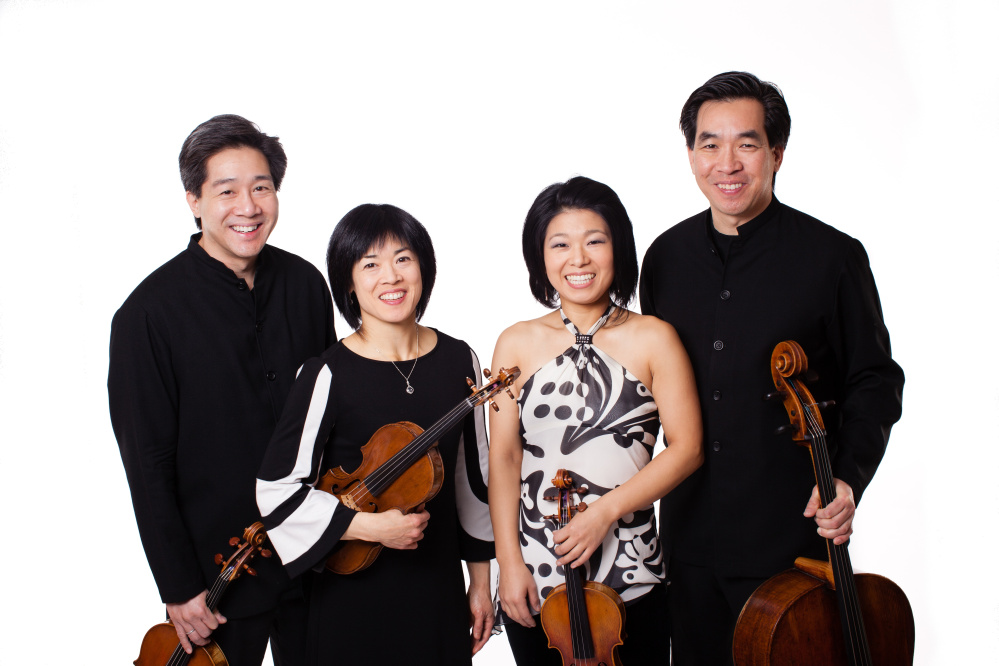Portland Ovations‘ place in the city’s musical ecology is predicated on its ability to bring nationally and internationally prominent soloists and ensembles to town, and this season it has done a superb job by putting its spotlight mainly on ensembles that have taken a few steps off the beaten path. Its final presentation of the season, at Hannaford Hall on Saturday afternoon, was a collaboration between the Ying Quartet and the cellist Zuill Bailey. Both Bailey and the quartet have recorded plentifully in recent years, and their reputations are estimable and growing. And the Yings, of course, have a Maine connection as well, as the ensemble-in-residence at the Bowdoin International Music Festival.
The Yings offered glimpses of two ongoing projects on Saturday. The first is “LifeMusic,” a commissioning program in which the group is asking composers to write works that reflect contemporary American life. The second, which involves Bailey, is a plan to revamp the string quintet repertory by exploring quintet arrangements of scores originally composed for other forces – in this case, Schumann’s Cello Concerto and, in a bigger stretch, Beethoven’s “Kreutzer” Sonata.
From the commissioning program, the group revisited a work composed for it in 2012, Billy Childs’ emotionally charged “Awakening.” Childs is best known as a jazz pianist, whose work has won four Grammy awards. But he also has a firm mastery of contemporary classical style, and there is nothing in “Awakening” that would suggest its composer’s jazz connections.
The three-movement, 18-minute work is in some ways an introspective diary, covering a period in 2011 when his wife suffered a pulmonary embolism and was rushed to the emergency room. Its opening movement, “Wake-Up Call,” is fast and energetic, built on tense tremolando figures, eerily whistling harmonies and dark, angular theme fragments. You scarcely need the composer’s program note to feel the shock and anxiety it embodies, capturing as it does Childs’ first reaction to his wife’s condition.
That anxiety is hardly lessened in “The White Room,” the meditative, melancholy central movement, which evokes the sense of not knowing what the outcome will be. But it is presented in a more considered, or at least less raw, perspective. In the finale, “Song of Healing,” the scoring is gentler still, and includes an exquisitely arching viola line. But though the title may lead you to expect a contemporary equivalent of Beethoven’s “Heiliger Dankgesang,” jubilation remains at arm’s length.
For all that, there is nothing grim about Childs’ powerful work. It is dramatic and passionate, and the quartet played it with all the intensity and dark beauty that the subject, and Childs’ scoring, demands.
The quintet arrangements, by contrast, offered something more in the line of light-spirited fun – but not without raising a few questions. There are reasons, after all, that arrangements are frowned upon in some circles. Particularly in works as familiar as the Schumann and the Beethoven, they thwart our expectations, giving us music we know in timbres we don’t expect – timbres different from those the composers chose.
That said, there is historical precedent for transcribing the works on hand. Schumann suggested to a publisher that a quintet version of his Cello Concerto might be appealing, but the idea was not taken up until relatively recently. The version the Yings and Bailey played, by Philip Lasser, works well enough that you barely miss the winds and brass of the original scoring. Its real appeal is that while the solo cello line retains its virtuosity and its singing character, it is less the star of the production than a voice that blends cozily into the ensemble texture.
The “Kreutzer,” heard in an uncredited arrangement published in 1832, five years after Beethoven’s death, is a bit stranger. There is no denying that the opening chordal passage loses a good deal of its vital tension when played by an ensemble rather than a single violinist. But that failing was quickly forgotten. Much of the solo violin line is kept intact, and the group’s first violinist, Robin Scott, gave it an electrifying reading. And if the piano writing, transferred to strings, loses some of its tactile, percussive quality, its excitement is preserved, and in some ways magnified. And the ensemble – which also includes Janet Ying, violin; Phillip Ying, viola; and David Ying, cello – gave it a vivid, high-energy performance that was fully Beethovenian in spirit.
Allan Kozinn is a former music critic and culture writer for The New York Times who lives in Portland. He can be contacted at:
allankozinn@gmail.com
Twitter: kozinn
Send questions/comments to the editors.



Comments are no longer available on this story